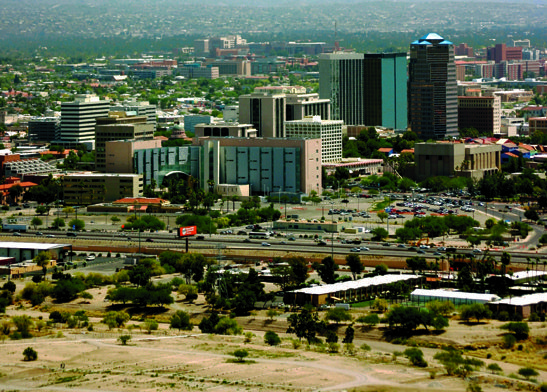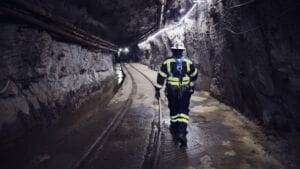Like the rest of the state, Southern Arizona has been in a recession since 2007, and at least one prominent economist says the situation won’t be getting better anytime soon.
“My forecast is that it’s going to take a while to get (credit markets) straightened out again and functioning as they should,” says Marshall Vest, director of the Economic and Business Research Center at the University of Arizona’s Eller College of Management. “I think that takes up most of 2009. Then we have all the excess housing that needs to be absorbed. That’s going to take some time and we’re not really absorbing the housing right now because credit markets have been essentially frozen. So, I think it’s the end of 2009 before the economy really regains its footing. I think we’ll start to move up in 2010. By move up, I mean the economy will once again begin to expand and enter a recovery phase.”
Joe Snell, president and CEO of Tucson Regional Economic Opportunities (TREO), says that despite the already deteriorating economic conditions, Tucson still managed to draw new companies and expansions in 2008.
“We’re definitely seeing a slow down in a lot of ways, both in the recruitment of companies and the expansion of companies, but not a massive downtick,” he says. “Our pipeline is as full as it’s ever been. But what we are seeing are companies that may have been ready to announce a $100 million expansion in November saying, ‘We’re going to wait on that until January, we’re cautious, we want to see what’s going to happen in the next three months.’ ”
Last year, the region still saw growth in the health care, bioscience, alternative energy and aerospace industries. Of particular note was the purchase of Ventana Medical Systems in Oro Valley by Swiss drug maker Roche for $3.4 billion. Roche also announced plans for a $100 million expansion at Ventana that would increase employment from 750 to about 1,000. In addition, Roche purchased more than 17 acres of land around the Ventana site to expand the location.
“Possibly the most significant thing we can point to though, is that 57 percent of the successful projects were in our targeted industries, and that’s important because those targeted industries represent quality rather than quantity, meaning, closing the wage gap,” Snell says. “Historically, Tucson has ranked somewhat below both the state and the national average in wages. So we’re rapidly moving in the right direction to close that gap. To me, that’s a big takeaway.”
Southern Arizona has not been immune to the effects of the housing market collapse and its devastating impact on the construction industry. For example, one of the first companies TREO recruited, window and doormaker Pella Corp., announced in November 2008 that it was idling its Tucson plant, affecting 65 workers. When Pella first located to Tucson in 2005, company officials said it had plans to employ more than 400 people at its facility.
Still, as Vest points out, since the construction boom was not as great in Southern Arizona as it was in the Phoenix area, the drop has been less precipitous. For example, year-over-year job losses in the construction industry in October 2008 stood at 4,000 in the Tucson metro area, according to figures from the Arizona Department of Commerce. In the Phoenix-Scottsdale-Mesa area, 30,000 construction industry jobs were lost during the same period.
“Commercial (construction) is still in relatively good shape. Vacancy rates are moving up, but they are still fairly low. Tucson didn’t see the construction boom in commercial that you saw in Phoenix, so, commercial construction here in Tucson doesn’t have as far to fall,” Vest says. “For residential, the indicators that I see are pretty comparable to Phoenix, except for the housing price data. I don’t think the declines have been quite as large (in Southern Arizona).”
Snell says that so far, Southern Arizona has managed to hold its own on employment.
“We have losses in construction, but we’re gaining it on biotech, we’re gaining it on solar, we’re gaining it in logistics companies. I think right now we’re sort of a wash,” he says.
Vest, however, expects more job losses across the state as the recession drags on through 2009. In fact, comparisons of unemployment rates from 2007 and 2008 already are startlingly eye opening.
In October 2008, the unemployment rate for the state, the Phoenix metro and the Tucson metro stood at 6.1 percent, 5.5 percent and 5.8 percent, respectively. In October 2007, the state’s unemployment rate was 3.9 percent, Phoenix’s was at 3.4 percent, and Tucson came in at 3.9 percent.
“I think the unemployment rate will likely reach 8 percent before we’re through,” Vest says.
Vest adds that rate is in line with the jobless figures of the last major recession of the early 1980s. Back then, unemployment peaked at 13 percent in the state, 8.9 percent in Phoenix and 10.5 percent in Tucson.
Fortunately for Southern Arizona, Vest says, the region’s economy is considerably more diverse than it was in the early ’80s. But with credit still tight and the housing market stuck in freefall, Vest cautions about being too optimistic on the strength of a recovery.
“I really think this recovery is probably going to be muted. I don’t see us rebounding very strongly. The process is going to take awhile,” he says. “This recession is going to be longer than the recessions of the early ’80s or mid ’70s. If it stretches through 2009 and the recession began in the fourth quarter of 2007, we’re talking about a two-year-long recession. Nationwide, the longest recession has been 16 months.
“It’s been a very long time in this country since we have encountered a very severe recession. The recessions of 2001 and 1991 were both very short and shallow. They barely qualified as recessions, rather than a growth slowdown. It’s only the gray hairs that remember what a severe recession is like,” Vest adds. “This is scary. This is messy. But we’ve been through this before. If you are a business and you can hang on and remain solvent and get through this, there will be plenty of opportunities on the other side. I would also say that it’s during times like this that the seeds are sown for fortunes to be made. Savvy investors will take positions in markets where assets are cheap and will benefit handsomely as the economy recovers —as surely it will. And the deep pockets know that and there is a lot of money on the sidelines waiting for the right opportunity.”
Snell agrees, adding that now is the time for Southern Arizona to stake a claim in future growth and prosperity.
“We’re not going to ride out the recession. I’m a big believer that now is the time to get aggressive,” he says. “I think we have a good head of steam. At this point, I would say Tucson is as competitive as any major city in the country, including Phoenix. That’s a first for us. Are we going to get cooled off by the national economy? Yes, absolutely. But I think we’re in as good a position as anyone coming out of this recession to capitalize, and maybe within this recession to capitalize.”
www.arizona.edu
www.treoaz.org
www.azcommerce.com




